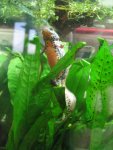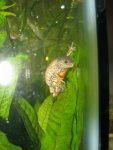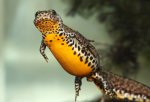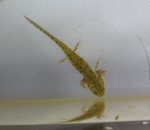-
Did you know that registered users see fewer ads? Register today!
- Advanced Discussion
- Species, Genus & Family Discussions
- Eurasian Newts (Triturus, former Triturus, etc.)
You are using an out of date browser. It may not display this or other websites correctly.
You should upgrade or use an alternative browser.
You should upgrade or use an alternative browser.
She POPPED! shePOPPED! she POPPED!
- Thread starter Molch
- Start date
Molch
Well-known member
- Joined
- Sep 28, 2010
- Messages
- 1,385
- Reaction score
- 43
- Points
- 48
- Country
- United States
holy granola! I have far more eggs than I thought. Tonight, I took some of the planters out of their tank because I wanted to take out the Ludwigia and Wisteria, which aren't growing all that well, and plant Elodea and Shinnersia instead.
Turns out the old girl has pegged lots of eggs into all the plants; I found them in the Wisteria, Ludwigia, Bacopa, Rotala - everywhere. I could not see these by looking into the tank. I removed all clippings with eggs and put them in a shallow tank with a bubble stone. I got 23 eggs in that one and probably at least as many left in the tank....and they are definitely developing; some of the embryos look comma-shaped already
Turns out the old girl has pegged lots of eggs into all the plants; I found them in the Wisteria, Ludwigia, Bacopa, Rotala - everywhere. I could not see these by looking into the tank. I removed all clippings with eggs and put them in a shallow tank with a bubble stone. I got 23 eggs in that one and probably at least as many left in the tank....and they are definitely developing; some of the embryos look comma-shaped already
Molch
Well-known member
- Joined
- Sep 28, 2010
- Messages
- 1,385
- Reaction score
- 43
- Points
- 48
- Country
- United States
Molch
Well-known member
- Joined
- Sep 28, 2010
- Messages
- 1,385
- Reaction score
- 43
- Points
- 48
- Country
- United States
The first larvae hatched!
If anyone wants to do the math, these eggs were laid on Jan 5 and hatched on Jan 31 - so 26 days at 60 F.
My goodness, they are so small. But the mouth is the biggest thing on them, which gives me hope they'll be little eating machines. I hope they can handle young D. magna. I also have some pulex, but not many, and am awaiting brine shrimp eggs in the mail.
How long before the larva start eating? I understand they have to absorb some yolk first, right? Also, is a sponge filter safe with larvae from the start?
If anyone wants to do the math, these eggs were laid on Jan 5 and hatched on Jan 31 - so 26 days at 60 F.
My goodness, they are so small. But the mouth is the biggest thing on them, which gives me hope they'll be little eating machines. I hope they can handle young D. magna. I also have some pulex, but not many, and am awaiting brine shrimp eggs in the mail.
How long before the larva start eating? I understand they have to absorb some yolk first, right? Also, is a sponge filter safe with larvae from the start?
Last edited:
Azhael
Site Contributor
- Joined
- May 7, 2007
- Messages
- 6,644
- Reaction score
- 121
- Points
- 0
- Location
- Burgos
- Country
- Spain
- Display Name
- Rodrigo
It usually takes about 2 to 7 days for the larvae to start feeding, depending on how much yolk they still have, but it generally doesn´t take long.
A sponge filter should do fine, no risk of the larvae getting sucked through the media. Keep the current low, though.
Good luck by the way I should have my first larva in a few days, we are rather syncronized xD
I should have my first larva in a few days, we are rather syncronized xD
A sponge filter should do fine, no risk of the larvae getting sucked through the media. Keep the current low, though.
Good luck by the way
Molch
Well-known member
- Joined
- Sep 28, 2010
- Messages
- 1,385
- Reaction score
- 43
- Points
- 48
- Country
- United States
some of the larvae are eating now. They started at 4 days of age. I can see them hop forward as they snap at tiny Daphnia.
Funnily, I found two larvae in one of my Daphnia tubs! First, I was very puzzled, as the Daphnia are in a different room and I use different equipment for them. Then, I remembered that when I set the Daphnia tubs up 3 weeks ago, I put a few bits of floating Riccia from the newt tank in there. I didn't think the fat lady would have pegged any eggs into the Riccia, but apparently she did. I left the two lucky candidates in the Daphnia tub; if they maximize on their opportunities, they should growto be the fattest of the whole lot.
Funnily, I found two larvae in one of my Daphnia tubs! First, I was very puzzled, as the Daphnia are in a different room and I use different equipment for them. Then, I remembered that when I set the Daphnia tubs up 3 weeks ago, I put a few bits of floating Riccia from the newt tank in there. I didn't think the fat lady would have pegged any eggs into the Riccia, but apparently she did. I left the two lucky candidates in the Daphnia tub; if they maximize on their opportunities, they should growto be the fattest of the whole lot.
Last edited:
RobM
New member
- Joined
- Jan 14, 2010
- Messages
- 477
- Reaction score
- 13
- Points
- 0
- Location
- London / Kent
- Country
- United Kingdom
- Display Name
- Rob M.
Is the daphnia water an OK quality though Molch?
You sure like your fat newts
You sure like your fat newts
Molch
Well-known member
- Joined
- Sep 28, 2010
- Messages
- 1,385
- Reaction score
- 43
- Points
- 48
- Country
- United States
I tested the water they are in, and it's zero on NH3, N02 and NO3. Those Daphnia tubs have a lot of hornwort in them; it helps suck up N.
isn't that a blessing in, like, Ghana or someplace: "May you have obedient wives and Fat Children!"
You sure like your fat newts
isn't that a blessing in, like, Ghana or someplace: "May you have obedient wives and Fat Children!"
Last edited:
RobM
New member
- Joined
- Jan 14, 2010
- Messages
- 477
- Reaction score
- 13
- Points
- 0
- Location
- London / Kent
- Country
- United Kingdom
- Display Name
- Rob M.
isn't that a blessing in, like, Ghana or someplace: "May you have obedient wives and Fat Children!"
Sounds like an advert for mail order brides to me!
- Joined
- Oct 14, 2004
- Messages
- 3,259
- Reaction score
- 63
- Points
- 48
- Location
- Bristol
- Country
- United Kingdom
I wish mine would pop soon. The females are starting to look like zeppelins floating around the tank. I witnessed the full breeding ritual the other day for the first time - from tail fanning right through to spermatophore pickup. I was surprised at how excitable the female became towards the end. It was a lot more frantic than I imagined. Even external fertilisation rocks for some creatures  .
.
Attachments
Molch
Well-known member
- Joined
- Sep 28, 2010
- Messages
- 1,385
- Reaction score
- 43
- Points
- 48
- Country
- United States
Even external fertilisation rocks for some creatures.
technically, it's internal fertilization - but external copulation. The human equivalent might be if you could pick up your sperm packet via mail-order at the post office, go home, and...ya know.
Back to the G-rated show.
Molch
Well-known member
- Joined
- Sep 28, 2010
- Messages
- 1,385
- Reaction score
- 43
- Points
- 48
- Country
- United States
well, the two in the Daphnia tub died  Not sure why - the water tests perfectly, but I wonder if they couldn't handle the Daphnia food?
Not sure why - the water tests perfectly, but I wonder if they couldn't handle the Daphnia food?
So now, having murdered the first larva, I'm a bit worried now about what to do to them right after they hatch. All other hatchlings (ca. 7 so far) are in a small plastic (ca. 4 ga) tank that contains the java fern thicket the fat lady used for laying. There are at least 20 more eggs about to hatch in there. There are a few snails which eat algae off the fern. The snails poop. The hatchlings hide in the fern during the day but at night I see them come out. I put a fair amount of Daphnia in there. I fished the biggest Daphnia out and the remaining ones range from barely visible to the size of the hatchlings' heads. Water is stable, temp is 60 F, and there is an open airline bubbling gently - does that sound like a good setup to get them started? Should they start eating when they are ready? I also have a 20 ga with an established foam filter that contains plant clipping with more eggs that will hatch in the next weeks.
What's a "normal" mortality rate in the first week or so, before they begin to eat?
So now, having murdered the first larva, I'm a bit worried now about what to do to them right after they hatch. All other hatchlings (ca. 7 so far) are in a small plastic (ca. 4 ga) tank that contains the java fern thicket the fat lady used for laying. There are at least 20 more eggs about to hatch in there. There are a few snails which eat algae off the fern. The snails poop. The hatchlings hide in the fern during the day but at night I see them come out. I put a fair amount of Daphnia in there. I fished the biggest Daphnia out and the remaining ones range from barely visible to the size of the hatchlings' heads. Water is stable, temp is 60 F, and there is an open airline bubbling gently - does that sound like a good setup to get them started? Should they start eating when they are ready? I also have a 20 ga with an established foam filter that contains plant clipping with more eggs that will hatch in the next weeks.
What's a "normal" mortality rate in the first week or so, before they begin to eat?
Molch
Well-known member
- Joined
- Sep 28, 2010
- Messages
- 1,385
- Reaction score
- 43
- Points
- 48
- Country
- United States
an update on the larvae: I'm raising about 25 in a controlled set-up with daily water changes and feedings of artemia, Daphnia and white worms. I've had few losses and they are growing and eating well. A few more are growing up in the parents' tank (see "Meet Hannibal" thread).
The oldest are now 2 months old and ca. 1.5 " long (see pix below). Soon I'll start them on bloodworms in addition to what they already eat.
A question: when should I look out for signs of metamorphosis? How long should they be before they metamorphose? Will they need access to land even though they are an aquatic subspecies?
Also, I'm thinking of transferring some of these to an established 10-ga tank planted w. java fern and hornwort and Daphnia for a less intense raising, but with a steady supply of Daphnia and white worms and feedings of blood worms. Is that a bad idea? Will they weather the change at this age?
The oldest are now 2 months old and ca. 1.5 " long (see pix below). Soon I'll start them on bloodworms in addition to what they already eat.
A question: when should I look out for signs of metamorphosis? How long should they be before they metamorphose? Will they need access to land even though they are an aquatic subspecies?
Also, I'm thinking of transferring some of these to an established 10-ga tank planted w. java fern and hornwort and Daphnia for a less intense raising, but with a steady supply of Daphnia and white worms and feedings of blood worms. Is that a bad idea? Will they weather the change at this age?
Attachments
eljorgo
Banned
oh oh oh! Really really neat looking!!  I wish I am myself an opportunity to raise from eggs Mesotriton larvae, they are just really unique! One day.... one day
I wish I am myself an opportunity to raise from eggs Mesotriton larvae, they are just really unique! One day.... one day 
they look really neat, congratz molche
they look really neat, congratz molche
Molch
Well-known member
- Joined
- Sep 28, 2010
- Messages
- 1,385
- Reaction score
- 43
- Points
- 48
- Country
- United States
A question: when should I look out for signs of metamorphosis? How long should they be before they metamorphose?
Will they need access to land even though they are an aquatic subspecies?
Also, I'm thinking of transferring some of these to an established 10-ga tank planted w. java fern and hornwort and Daphnia for a less intense raising, but with a steady supply of Daphnia and white worms and feedings of blood worms. Is that a bad idea? Will they weather the change at this age?
bumpety-bump..:wacko:..anyone have any input on this? Mostly i'm wondering if and when I should give them access to land?
RobM
New member
- Joined
- Jan 14, 2010
- Messages
- 477
- Reaction score
- 13
- Points
- 0
- Location
- London / Kent
- Country
- United Kingdom
- Display Name
- Rob M.
They look so cool! Congrats Molch
Azhael
Site Contributor
- Joined
- May 7, 2007
- Messages
- 6,644
- Reaction score
- 121
- Points
- 0
- Location
- Burgos
- Country
- Spain
- Display Name
- Rodrigo
They are just lovely, well done!
Mine are younger, i can´t wait for them to look so nice xD
Metamorphosis is usually predictable by a series of changes in the larva. Belly coloration starts to appear, the limbs become thicker, the head usually becomes more adult-like and the dorsal and caudal crests disappear. The last thing to go are the gills which can be reabsorved quite fast.
I think yours still may have a few weeks to reach that point, but it could happen sooner than that. It should really become rather obvious when they are ready, so don´t panic.
Definitely offer easily accesible land areas. While apuanus is indeed very aquatic, juveniles can remain terrestrial for some time. Even if they return to the water early on, they will need a terrestrial period. The odd one may possibly remain aquatic at all times, but there is a risk of drowning and the norm is for them to go terrestrial. Good thing is, though, that they usually go back to water while still juvenile.
I have no personal experience yet with metamorph sizes, but i think most people report morphs about 3-4 cm long. Then again, there´s always the rare possibility that some may remain in the larval form for longer in a state of facultative neoteny, and even attain adult sizes and maturity before morphing.
As for housing them in a larger, more naturalistic tank, i´d say go for it. I like that method, it just works better for me. You´ll have to keep a close eye on them if you house them in deeper water, and it may be a good idea to remove very advanced larvae that are in the brink of morphing, so that they can do so in a shallow semi-terrestrial tank.
Mine are younger, i can´t wait for them to look so nice xD
Metamorphosis is usually predictable by a series of changes in the larva. Belly coloration starts to appear, the limbs become thicker, the head usually becomes more adult-like and the dorsal and caudal crests disappear. The last thing to go are the gills which can be reabsorved quite fast.
I think yours still may have a few weeks to reach that point, but it could happen sooner than that. It should really become rather obvious when they are ready, so don´t panic.
Definitely offer easily accesible land areas. While apuanus is indeed very aquatic, juveniles can remain terrestrial for some time. Even if they return to the water early on, they will need a terrestrial period. The odd one may possibly remain aquatic at all times, but there is a risk of drowning and the norm is for them to go terrestrial. Good thing is, though, that they usually go back to water while still juvenile.
I have no personal experience yet with metamorph sizes, but i think most people report morphs about 3-4 cm long. Then again, there´s always the rare possibility that some may remain in the larval form for longer in a state of facultative neoteny, and even attain adult sizes and maturity before morphing.
As for housing them in a larger, more naturalistic tank, i´d say go for it. I like that method, it just works better for me. You´ll have to keep a close eye on them if you house them in deeper water, and it may be a good idea to remove very advanced larvae that are in the brink of morphing, so that they can do so in a shallow semi-terrestrial tank.
Molch
Well-known member
- Joined
- Sep 28, 2010
- Messages
- 1,385
- Reaction score
- 43
- Points
- 48
- Country
- United States
thanks Azhael for the thorough answer. As for morph sizes, my bigger ones are 4-4.5 cm now, but as yet show no physical signs of morphing. I'll make sure they have islands and lots of hornwort at the water surface when they get there.
Also, I think they are big enough now to start on bloodworms.
btw, is there any data showing whether they are more likely to morph small if food supply is limited or the tank is crowded? This might make sense in the wild when vernal ponds begin to dry up. On the other hand, when you got lots of good grub, it would be best to maximize on that opportunity to get big before you morph and stay aquatic longer....
Also, I think they are big enough now to start on bloodworms.
btw, is there any data showing whether they are more likely to morph small if food supply is limited or the tank is crowded? This might make sense in the wild when vernal ponds begin to dry up. On the other hand, when you got lots of good grub, it would be best to maximize on that opportunity to get big before you morph and stay aquatic longer....
esnailme
New member
- Joined
- Mar 10, 2009
- Messages
- 139
- Reaction score
- 2
- Points
- 0
- Country
- United States
I am also excited for you.
First l am sorry your 2 babies did not make it. My theory is:
All parameters were on target. Usually the daphnia culture does not require an air line so they most likely died from of lack of oxygen.
If the larva are in tanks with cycled media.......are you doing daily water changes?
First l am sorry your 2 babies did not make it. My theory is:
All parameters were on target. Usually the daphnia culture does not require an air line so they most likely died from of lack of oxygen.
If the larva are in tanks with cycled media.......are you doing daily water changes?
- Advanced Discussion
- Species, Genus & Family Discussions
- Eurasian Newts (Triturus, former Triturus, etc.)
General chit-chat
- No one is chatting at the moment.








